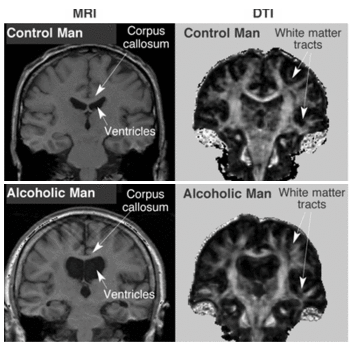Alcoholism

Images of a 61-year-old healthy man (upper images) and a 60-year-old alcoholic man (lower images). Note on the MRI the thinner corpus callosum displaced upward by enlarged ventricles and, on the DTI, less well delineated white matter tracts in the alcoholic man compared with the healthy man.
Alcoholism is a chronic condition, the development and presentation of which is influenced by genetic, psychosocial, and environmental factors. As a disease process, it is often progressive, and sometimes fatal. Alcoholism is typically characterized by impaired impulse control, preoccupation with alcohol, continued use of alcohol despite adverse consequences, and a generalized distortion in thinking. While the condition itself is considered chronic, the symptom profile may present either continuously or periodically." [1]
Etiology / cause
Alcoholism is "probably a multifactorial, genetically influenced disorder" and twin studies show a "55% or higher concordance rate in monozygotic twins with only a 28% rate for like-sex dizygotic twins."[2]
Alcoholic styles
Chronic drinking
Maintenance drinking
Binge drinking
Blackout drinking
Recovery styles
The 'dry drunk'
In recovery
Post-recovery
Diagnosis
A systematic review concluded "full AUDIT may be superior to the AUDIT-C."[3]
One question, "'How many times in the past year have you had X or more drinks in a day?', where X is 5 for men and 4 for women, and a response of >1 is considered positive" has accuracy of:[4]
- Sensitivity 82%
- Specificity 79%
Hair analysis
Hair analysis can detect alcohol consumption by measuring fatty acid ethyl esters and ethyl glucuronide that are metabolites of ethanol.[5][6]
Treatment
Medications
Baclofen
Baclofen is a a selective GABA B-receptor agonist that in a single trial of patients with alcoholic cirrhosis improved abstinence rates (71% versus 29%) over three months.[7]
Disulfiram
A randomized controlled trial showed benefit from disulfiram [8]
Topiramate
A randomized controlled trial of volunteers showed benefit from topiramate.[7]
Naltrexone
Randomized controlled trials show conflicting benefit from naltrexone with benefit among recent abstainers[9] and no benefit from chronic users[10].
See also
References
- ↑ National Library of Medicine. Alcoholism. Retrieved on 2007-12-06.
- ↑ Alcohol Dependence. (Online Mendelian Inheritance in Man, OMIM®. Johns Hopkins University, Baltimore, MD. MIM Number: 103780. World Wide Web URL: http://omim.org/.)
- ↑ Kriston L, Hölzel L, Weiser AK, Berner MM, Härter M (December 2008). "Meta-analysis: are 3 questions enough to detect unhealthy alcohol use?". Ann. Intern. Med. 149 (12): 879–88. PMID 19075207. [e]
- ↑ Smith, Peter; Susan Schmidt, Donald Allensworth-Davies, Richard Saitz (2009-07-01). "Primary Care Validation of a Single-Question Alcohol Screening Test". Journal of General Internal Medicine 24 (7): 783-788. DOI:10.1007/s11606-009-0928-6. PMID 19247718. Retrieved on 2009-06-16. Research Blogging.
- ↑ Pragst F, Balikova MA (August 2006). "State of the art in hair analysis for detection of drug and alcohol abuse". Clin. Chim. Acta 370 (1-2): 17–49. DOI:10.1016/j.cca.2006.02.019. PMID 16624267. Research Blogging.
- ↑ Pragst F, Yegles M (April 2008). "Determination of fatty acid ethyl esters (FAEE) and ethyl glucuronide (EtG) in hair: a promising way for retrospective detection of alcohol abuse during pregnancy?". Ther Drug Monit 30 (2): 255–63. DOI:10.1097/FTD.0b013e318167d602. PMID 18367991. Research Blogging.
- ↑ 7.0 7.1 2007. Lancet Cite error: Invalid
<ref>tag; name "pmidpending" defined multiple times with different content - ↑ Fuller RK, Branchey L, Brightwell DR, et al (1986). "Disulfiram treatment of alcoholism. A Veterans Administration cooperative study". JAMA 256 (11): 1449–55. PMID 3528541. [e]
- ↑ Anton RF, O'Malley SS, Ciraulo DA, et al (2006). "Combined pharmacotherapies and behavioral interventions for alcohol dependence: the COMBINE study: a randomized controlled trial". JAMA 295 (17): 2003–17. DOI:10.1001/jama.295.17.2003. PMID 16670409. Research Blogging.
- ↑ Krystal JH, Cramer JA, Krol WF, Kirk GF, Rosenheck RA (2001). "Naltrexone in the treatment of alcohol dependence". N. Engl. J. Med. 345 (24): 1734–9. DOI:10.1056/NEJMoa011127. PMID 11742047. Research Blogging.